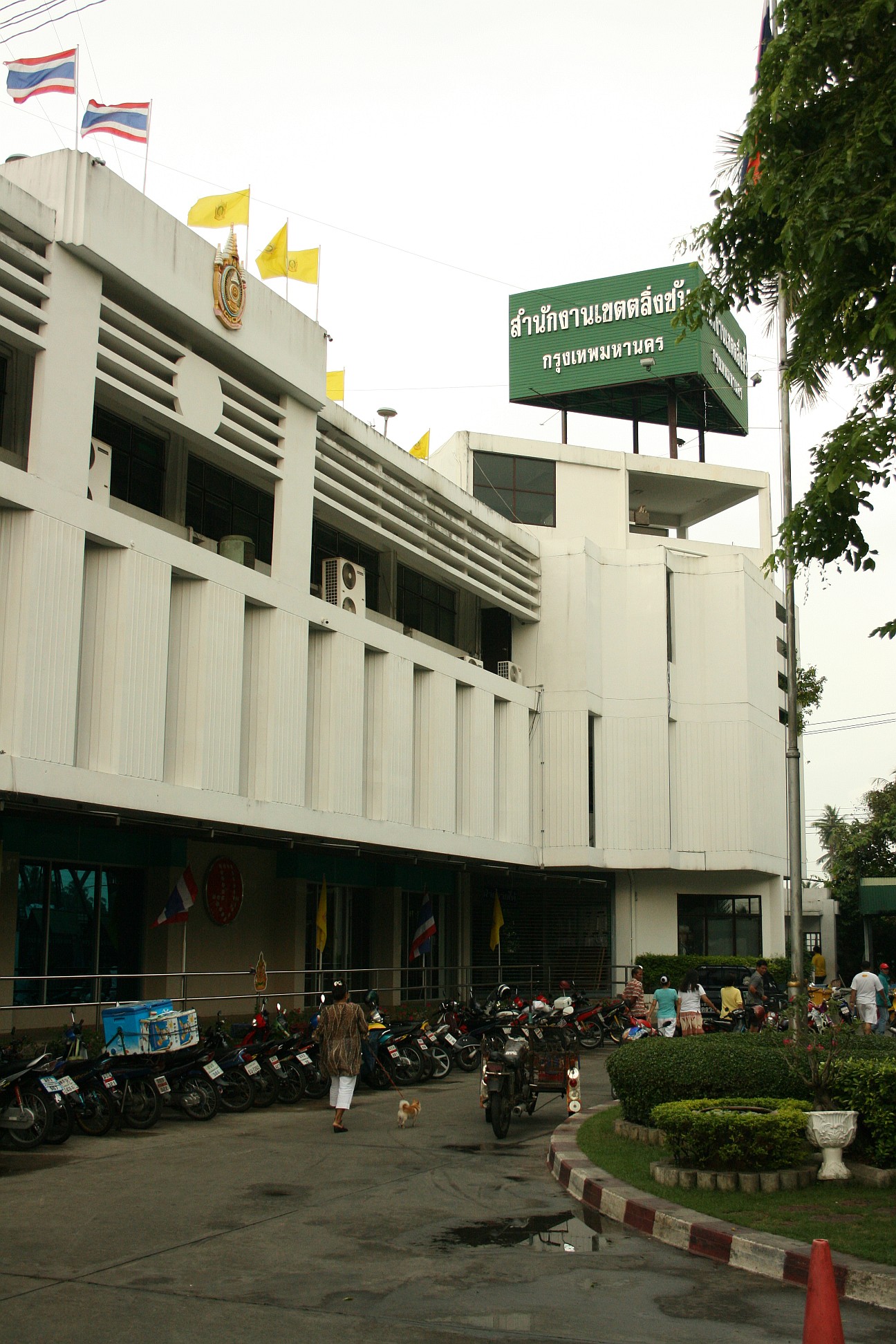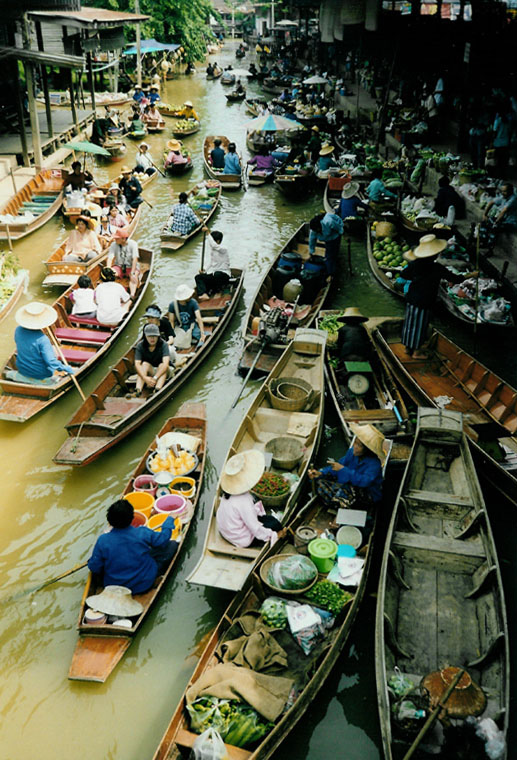|
Wat Ko, Bangkok
250px, Wat Ko in 2023 Wat Ko ( th, วัดเกาะ, ) is a Buddhist temple of over 320 years old in the area of Bang Chueak Nang Subdistrict, Taling Chan District, Bangkok. The temple was built during the late Ayutthaya period, but the exact builder name is unknown. It is located on a land surrounded by two waterways Khlong Bang Chueak Nang and Khlong Bang Noi, hence the name "Wat Ko", which means "island temple". This temple is believed to have been built since the late Ayutthaya period, more than 300 years old. The principle Buddha named ''Luang Pho Dam'' (หลวงพ่อดำ) that enshrined in the sanctuary Chinese-styled roof. One of the highlights of this temple is the ancient chedi located on the right side of the sanctuary rim Khlong Bang Noi. Wat Ko is a small and quiet temple, and cannot be reached by car. This temple is the destination of water tourism by long-tail boat from Taling Chan floating market Taling Chan ( th, ตลิ่งชัน, ) ... [...More Info...] [...Related Items...] OR: [Wikipedia] [Google] [Baidu] |
Bang Chueak Nang Subdistrict
Bang Chueak Nang ( th, บางเชือกหนัง, ) is one of the six ''khwaengs'' (subdistricts) of Taling Chan District in Bangkok's Thonburi side. The subdistrict contained 12 administrative villages. History and toponymy Its name after Khlong Bang Chueak Nang that flows through the southern area and considered to be the main watercourse of locals. The khlong that separates from the Khlong Mon to the south, along with Khlong Bang Noi which separates to the west. Khlong Bang Chuek Nang has a starting point from the Wat Ko temple and long flowing as far as converging with Khlong Thawi Watthana in the area of Thawi Watthana District. Bang Chueak Nang is an area with a history of more than 500 years, along with the neighbouring Bang Ramat. They are mentioned in ''Kamsuan Samut'', an ancient literature from the early Ayutthaya period; and are hence considered as two of the oldest communities in Bangkok. Despite the name ''Bang Chueak Nang'' literally meaning "place ... [...More Info...] [...Related Items...] OR: [Wikipedia] [Google] [Baidu] |
Taling Chan District
Taling Chan ( th, ตลิ่งชัน, ) is one of the 50 districts (''khet'') of Bangkok, Thailand. Its neighbours, clockwise from the north, are Bang Kruai district of Nonthaburi province and Bang Phlat, Bangkok Noi, Bangkok Yai, Phasi Charoen, Bang Khae, and Thawi Watthana Districts of Bangkok. History Taling Chan is an old district back when there was Thonburi province. Now Thonburi is merged into Bangkok. In 1998, part of the district was split into a new Thawi Watthana district. Historically, much of the area was used as orchards and kitchen gardens, many remaining there today. It has been called "Bangkok's Kitchen". The landscape of Taling Chan about 1,000 years ago is believed to have been part of the Chao Phraya River delta. The area was a muddy mangrove forest and there was no evidence of human settlement. Two areas of Taling Chan, Bang Ramat and Bang Chueak Nang, were mentioned to in the ''Kamsuan Samut'' of the Ayutthaya period. They are regarded as a ... [...More Info...] [...Related Items...] OR: [Wikipedia] [Google] [Baidu] |
Bangkok
Bangkok, officially known in Thai as Krung Thep Maha Nakhon and colloquially as Krung Thep, is the capital and most populous city of Thailand. The city occupies in the Chao Phraya River delta in central Thailand and has an estimated population of 10.539 million as of 2020, 15.3 percent of the country's population. Over 14 million people (22.2 percent) lived within the surrounding Bangkok Metropolitan Region at the 2010 census, making Bangkok an extreme primate city, dwarfing Thailand's other urban centres in both size and importance to the national economy. Bangkok traces its roots to a small trading post during the Ayutthaya Kingdom in the 15th century, which eventually grew and became the site of two capital cities, Thonburi in 1768 and Rattanakosin in 1782. Bangkok was at the heart of the modernization of Siam, later renamed Thailand, during the late-19th century, as the country faced pressures from the West. The city was at the centre of Thailand's political struggl ... [...More Info...] [...Related Items...] OR: [Wikipedia] [Google] [Baidu] |
Ayutthaya Period
The Ayutthaya Kingdom (; th, อยุธยา, , IAST: or , ) was a Siamese kingdom that existed in Southeast Asia from 1351 to 1767, centered around the city of Ayutthaya, in Siam, or present-day Thailand. The Ayutthaya Kingdom is considered to be the precursor of modern Thailand and its developments are an important part of the History of Thailand. The Ayutthaya Kingdom emerged from the mandala of city-states on the Lower Chao Phraya Valley in the late fourteenth century during the decline of the Khmer Empire. After a century of territorial expansions, Ayutthaya became centralized and rose as a major power in Southeast Asia. Ayutthaya faced invasions from the Toungoo dynasty of Burma, starting a centuries' old rivalry between the two regional powers, resulting in the First Fall of Ayutthaya in 1569. However, Naresuan ( 1590–1605) freed Ayutthaya from brief Burmese rule and expanded Ayutthaya militarily. By 1600, the kingdom's vassals included some city-states in ... [...More Info...] [...Related Items...] OR: [Wikipedia] [Google] [Baidu] |
Waterway
A waterway is any navigable body of water. Broad distinctions are useful to avoid ambiguity, and disambiguation will be of varying importance depending on the nuance of the equivalent word in other languages. A first distinction is necessary between maritime shipping routes and waterways used by inland water craft. Maritime shipping routes cross oceans and seas, and some lakes, where navigability is assumed, and no engineering is required, except to provide the draft for deep-sea shipping to approach seaports ( channels), or to provide a short cut across an isthmus; this is the function of ship canals. Dredged channels in the sea are not usually described as waterways. There is an exception to this initial distinction, essentially for legal purposes, see under international waters. Where seaports are located inland, they are approached through a waterway that could be termed "inland" but in practice is generally referred to as a "maritime waterway" (examples Seine Maritime, ... [...More Info...] [...Related Items...] OR: [Wikipedia] [Google] [Baidu] |
Khlong Bang Chueak Nang
Bang Chueak Nang ( th, บางเชือกหนัง, ) is one of the six ''khwaengs'' (subdistricts) of Taling Chan District in Bangkok's Thonburi side. The subdistrict contained 12 administrative villages. History and toponymy Its name after Khlong Bang Chueak Nang that flows through the southern area and considered to be the main watercourse of locals. The khlong that separates from the Khlong Mon to the south, along with Khlong Bang Noi which separates to the west. Khlong Bang Chuek Nang has a starting point from the Wat Ko temple and long flowing as far as converging with Khlong Thawi Watthana in the area of Thawi Watthana District. Bang Chueak Nang is an area with a history of more than 500 years, along with the neighbouring Bang Ramat. They are mentioned in ''Kamsuan Samut'', an ancient literature from the early Ayutthaya period; and are hence considered as two of the oldest communities in Bangkok. Despite the name ''Bang Chueak Nang'' literally meaning "place o ... [...More Info...] [...Related Items...] OR: [Wikipedia] [Google] [Baidu] |
Chinese Architecture
Chinese architecture ( Chinese:中國建築) is the embodiment of an architectural style that has developed over millennia in China and it has influenced architecture throughout Eastern Asia. Since its emergence during the early ancient era, the structural principles of its architecture have remained largely unchanged. The main changes involved diverse decorative details. Starting with the Tang dynasty, Chinese architecture has had a major influence on the architectural styles of Japan, Korea, Mongolia, and Vietnam, and minor influences on the architecture of Southeast and South Asia including the countries of Malaysia, Singapore, Indonesia, Sri Lanka, Thailand, Laos, Cambodia and the Philippines. Chinese architecture is characterized by bilateral symmetry, use of enclosed open spaces, feng shui (e.g. directional hierarchies), a horizontal emphasis, and an allusion to various cosmological, mythological or in general symbolic elements. Chinese architecture traditionall ... [...More Info...] [...Related Items...] OR: [Wikipedia] [Google] [Baidu] |
Cetiya
upright=1.25, Stupa">Phra Pathom Chedi, one of the biggest Chedis in Thailand; in Thai, the term Chedi (cetiya) is used interchangeably with the term Stupa Cetiya, "reminders" or "memorials" (Sanskrit ''caitya''), are objects and places used by Buddhism, Buddhists to remember Gautama Buddha.Kalingabodhi jātaka, as quoted in John Strong, ''Relics of the Buddha'' (Princeton: Princeton University Press, 2004), 19 According to Damrong Rajanubhab, four kinds are distinguished in the Pāli Canon: "Relic hatu Memorial aribhoga Teaching hamma and votive desaka" Griswold, in contrast, states that three are traditional and the fourth, the Buddha Dhamma, was added later to remind monks that the true memory of Gautama Buddha can be found in his teachings. While these can be broadly called Buddhist symbolism, the emphasis tends to be on a historical connection to the Buddha and not a metaphysical one. In pre-Buddhist India ''caitya'' was a term for a shrine or holy place in the land ... [...More Info...] [...Related Items...] OR: [Wikipedia] [Google] [Baidu] |
Long-tail Boat
The long-tail boat, ( th, เรือหางยาว, , ) is a type of watercraft native to Southeast Asia, which uses a common automotive engine as a readily available and maintainable powerplant. A craft designed to carry passengers on a river may include a lightweight long canoe hull, up to 30 metres, and a canopy. There is much variation among these boats, some have evolved from traditional craft types, while others have a more improvised look—the sole defining characteristic is a second-hand car or truck engine. Long-tail boats are now often used to transport tourists. There are also competitions involving long-tail boats in some provinces of Thailand. Propulsion The engine is invariably mounted on an inboard turret-like pole which can rotate through 180 degrees, allowing steering by thrust vectoring. The propeller is mounted directly on the driveshaft with no additional gearing or transmission. Usually the engine also swivels up and down to provide a "neutral g ... [...More Info...] [...Related Items...] OR: [Wikipedia] [Google] [Baidu] |
Taling Chan Floating Market
Taling Chan ( th, ตลิ่งชัน, ) is one of the 50 districts (''khet'') of Bangkok, Thailand. Its neighbours, clockwise from the north, are Bang Kruai district of Nonthaburi province and Bang Phlat, Bangkok Noi, Bangkok Yai, Phasi Charoen, Bang Khae, and Thawi Watthana Districts of Bangkok. History Taling Chan is an old district back when there was Thonburi province. Now Thonburi is merged into Bangkok. In 1998, part of the district was split into a new Thawi Watthana district. Historically, much of the area was used as orchards and kitchen gardens, many remaining there today. It has been called "Bangkok's Kitchen". The landscape of Taling Chan about 1,000 years ago is believed to have been part of the Chao Phraya River delta. The area was a muddy mangrove forest and there was no evidence of human settlement. Two areas of Taling Chan, Bang Ramat and Bang Chueak Nang, were mentioned to in the ''Kamsuan Samut'' of the Ayutthaya period. They are regarded as am ... [...More Info...] [...Related Items...] OR: [Wikipedia] [Google] [Baidu] |

.jpg)
_of_Wat_Phra_Si_Sanphet.jpg)




